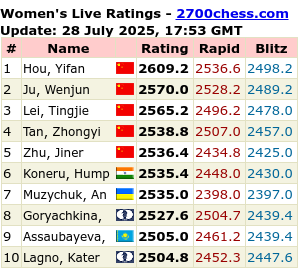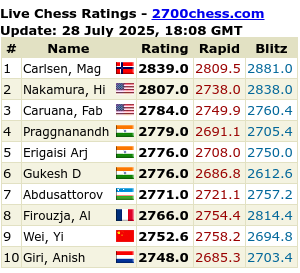5 September 2010, Kuala Lumpur – Developing an opening repertoire that can both scale up (be played with confidence against increasingly stronger opposition) and scale out (has sufficient complexity so that reasonable side-variations can be analysed and improved upon over time) is a more effective strategy than relying upon romantic gambits and fad openings. Learning mainstream openings initially requires more effort, but it is time well spent if the long-term goal is to improve your game. The problem with relying primarily upon second-rate openings is that they lose their effectiveness over time – opponents see them coming and can more easily prepare for them. The result is that you end up having to spend a lot of time changing your openings around if one of your fad variations runs into a problem – now all of the time spent studying last year’s fad opening is wasted.
A recommendation for building an opening repertoire is to pick one or two of the leading grandmasters whose style you are comfortable with, and emulate a few of their openings. Mainstream openings are so robust that the world’s best players are always developing new ideas which can be incorporated into your opening arsenal. These openings are in no danger of being refuted; they may run into problems occasionally in a particular variation, but antidotes are usually found. This methodology also ensures that you will be able to study a good supply of well-annotated complete games between strong players featuring your chosen openings. This is a real time-saver because it will reduce the amount of effort spent searching for suitable middlegame and endgame material. Your time is more productively spent studying mainstream openings that have withstood the test of time.
How should the club or weekend player go about determining the weakest part of the opponent’s opening repertoire? Experience has shown over an extended time-period as a player has convinced me that most club players tend to spend more time studying their white openings at the expense of their black openings. In the absence of any evidence such as a previous games with the opponent, ask yourself the following question: what opening move does the player favour with the white pieces? If the player opens with 1 e4, his weakest opening is usually defending against 1 d4, 1 c4 or 1 Nf3 – conversely, if the player opens with 1 d4, 1 c4 or 1 Nf3, his weakest opening is usually defending against 1 e4. The reason for this comes down to a numbers game. The king’s pawn player has a favourite defence against 1 e4 which he also has to play against with the white pieces, so he has more experience playing it and he probably spends more time studying it. His only experience with 1 d4,1 c4 or 1 Nf3 is when he is playing the black pieces. If you can, aim for the opening in which the opponent has the least amount of experience. This is a very effective strategy and it is a strong argument for eventually learning to play more than one opening move with the white pieces and more than one defence with the black pieces. The world’s leading players routinely vary their openings with both colours for several reasons:
- They are aiming for a particular variation in which they have prepared an improvement;
- They are seeking to exploit a real or imagined weakness in the opponent’s game;
- They are trying to reduce the chances of falling victim to an opponent’s opening preparations.
The time spent in studying particular opening variations should correlate to the appearance of these lines in your games. To ensure that you stay focused on making the most use of your study time, keep track of approximately how much time you spend studying each opening and compare it to your actual club or tournament experience. If there is a wide discrepancy between what you are analysing at home and what your opponents are playing, you need to make an adjustment and reallocate your study time to maximize the benefit per hour of study.
A good way of expanding your opening repertoire is to make use of your experience against particular openings by playing the opening yourself – you’re already familiar with many of the variations so the learnng curve is reduced. An additional benefit is that your opponents might play some strong ideas which you can use yourself with the other colour. Which opening should you consider adding to your repertoire? One reliable method is to start with a list of the openings your opponents have most frequently played against you.
Here is a probable list of openings to consider according to whether you consider yourself either a positional player or a tactical player.
Openings for positional players:
White: 1 d4, 1 c4, 1 Nf3,
Black against 1 e4: French, Caro-Kann, Petroff.
Black against 1 d4: QGD, QGA, Nimzo-Indian, Queen’s Indian.
Openings for tactical players:
White: 1 e4
Black against 1 e4: Sicilian, Pirc-Modern, Alekhine.
Black against 1 d4: King’s Indian, Grunfeld, Benoni, Benko, etc.
(adapted from Understanding Your Chess, James Rizzitano, 2004)
(adapted from Understanding Your Chess, James Rizzitano, 2004)






























No comments:
Post a Comment